#panel 1691
Explore tagged Tumblr posts
Text

this is so needlessly chaotic but so is act 4 so really if you think about it i'm imbibing the spirit of it all into a lot of gaussian blurring
#homestuck#rose lalonde#john egbert#dave strider#davesprite#terezi pyrope#karkat vantas#okay listen this is like a sloppy redraw of panel uhhh#panel 1691#it was not supposed to go like this#but hey um#you ever remember why you were so obsessed with a webcomic#because like i do#i really really do#this comic is so dumb and soooooooooooooooooooooooooooooo fruitful#and as a teenager guys I DID NOT APPRECIATE THE INTERMISSIONS#I PAID NO ATTENTION TO SPADES SLICK AND SNOWMAN AND SHIT UNTIL WAY LATER#AND SO NOW I'M LIKE MUCH MORE APPRECIATIVE#AND IT'S JUST#A REALLY FUCKING FUN TIME#TO BE REREADING#thank u jax for getting me hooked in#im seated and i'm reading#too many tags oops#art#rosemary to come soon i just reread their first like 2? pesterlogs and OOFJSGLKDJFGLKDFJGLDFKJDFGL#I EAT IT#IF UCKING EEEAAAAT IT#hey the way i'm 25#sorry to be cringe on my TUMBLR account
1K notes
·
View notes
Text

Girl with Doughnuts * - Albert Cuyp , c. 1652.
Dutch , 1620-1691
Oil on panel , 40 x 34 cm.
*Young maid holding a cooking pot full of oliebollen
70 notes
·
View notes
Text

Circle of Livio Mehus, ca.1630-1691
Nesso e Dejanira, n/d, oil on panel, round 29.5x29.5 cm
Private Collection
6 notes
·
View notes
Text

América y otros puntos de vista
Cultura: Flamenca Datación: Fechado en 1691 Artista: Ferdinand van Kessel (1648 Amberes - 1696 Breda) - GND Material/Tecnología: Lona Métricas: 52,5 × 60,5 cm Dimensiones del cuadro: 136 × 168,5 × 7 cm Firma: Panel central con la inscripción abajo a la izquierda: Ferd. van Kessel fe. 1691 Derechos de imagen: Kunsthistorisches Museum Viena, Gemäldegalerie Nº Inv.: Galería de imágenes, 2800 y otros
Información e imagen de la web del Kunsthistorisches Museum.
0 notes
Text
#FineArtFriday: Dordrecht Harbor by Moonlight by Aelbert Cuyp 1643
Artist: Aelbert Cuyp (1620–1691) Title: Dordrecht Harbor by Moonlight Genre: landscape art Date: 1643 Medium: oil on panel Dimensions: height: 76.5 cm (30.1 in); width: 106.5 cm (41.9 in) Collection: Wallraf–Richartz Museum What I like about this scene: Aelbert Cuyp’s paintbrush tells a story. But what kind of story is he showing us? A ship is docked beside a mill at Dordrecht Harbor. Night has…

View On WordPress
#17th century landscape paintings#Dordrecht Harbor by Moonlight by Aelbert Cuyp 1643#Dort#Fine Art Friday
0 notes
Photo

Nicolaes van Verendael - 'A monkey feast' or 'The King drinks' - 1686
oil on panel, height: 29 cm (11.4 in); width: 37.5 cm (14.7 in)
Gemäldegalerie Alte Meister, Dresden, Germany
Nicolaes van Verendael or Nicolaes van Veerendael (1640 in Antwerp – 1691 in Antwerp) was a Flemish painter active in Antwerp who is mainly known for his flower paintings and vanitas still lifes. He was a frequent collaborator of other Antwerp artists to whose compositions he added the still life elements. He also painted a number of singeries, i.e, scenes with monkeys dressed and acting as humans.
Nicolaes van Verendael contributed to the spread of the genre of the 'monkey scene', also called 'singerie' (a word, which in French means a 'comical grimace, behaviour or trick'). Comical scenes with monkeys appearing in human attire and a human environment are a pictorial genre that was initiated in Flemish painting in the 16th century and was subsequently further developed in the 17th century. The Flemish engraver Pieter van der Borcht introduced the singerie as an independent theme around 1575 in a series of prints, which are strongly embedded in the artistic tradition of Pieter Bruegel the Elder. These prints were widely disseminated and the theme was then picked up by other Flemish artists in particular by those in Antwerp such as Frans Francken the Younger, Jan Brueghel the Elder and the Younger, Sebastiaen Vrancx and Jan van Kessel the Elder. David Teniers the Younger became the principal practitioner of the genre and developed it further with his younger brother Abraham Teniers.
Later in the 17th century Nicolaes van Verendael started to paint these ‘monkey scenes’ as well. As he had collaborated with David Teniers the Younger in Antwerp, he was familiar with Teniers' work in this genre. An example is the Monkey feast which reprises the theme of 'The King drinks' with the human roles played by monkeys. Another example is the Merry Company or Singerie (Royal Museums of Fine Arts of Belgium, which depicts monkeys reveling in an inn. A considerable number of paintings and additional drawings of singeries by Veerendael has been identified on the art market and in private collections.
42 notes
·
View notes
Photo





The Baroque altarpiece in the choir of Saint-Jean-au-Marché in Troyes, France, was designed in 1663 by Michel Noblet in the Italian style. The two paintings - The Heavenly Father and The Baptism of Jesus - are by Pierre Mignard, a native of Troyes who later became the first painter to King Louis XIV. More than twenty years later a tabernacle was commissioned and added in 1691 by another artist born in Troyes, François Girardon. The gilded bronze door shows The Child Jesus Holding the Cross, and one of the decorative panels depicts John the Baptist. This is the only monumental altarpiece of its kind in any church in Troyes.
#Baroque Art#17th century#architecture#French artists#religious art#catholic church#historic building#places to see#travel photos
23 notes
·
View notes
Photo

Keep the #wip #moving on the #mothers #exodus from #Salem in #1691 #illustration #art #grabthecrown #comic #cartoon #witches #creepy #horror #panel #preparing to #flee (at Boston, Massachusetts) https://www.instagram.com/p/BqdymcggIEM/?utm_source=ig_tumblr_share&igshid=1cjj8ii5a8s3f
#wip#moving#mothers#exodus#salem#1691#illustration#art#grabthecrown#comic#cartoon#witches#creepy#horror#panel#preparing#flee
0 notes
Text
Dyrham Park
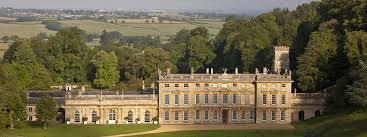
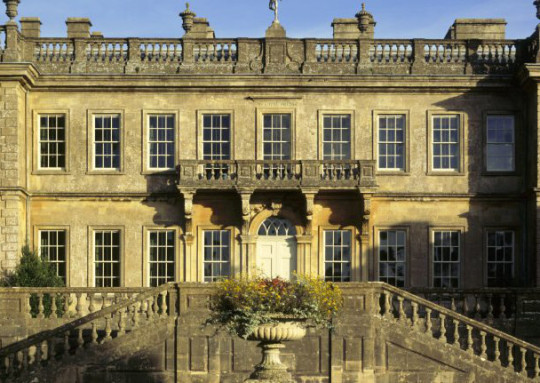

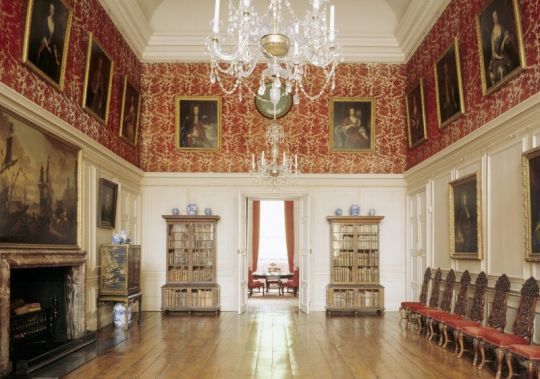

Dyrham Park is a baroque mansion located near the village of Dyrham in South Gloucestershire, England. The castle was built upon a previous manor by government administrator William Blathwayt from 1691 to 1704 on the western edge of the Cotswolds. Due to Blathwayt’s well-paying occupation in dealing with the colonies, many contents in the house have come from his career, including a tea table from Java, gilt leather panels from Amsterdam, many European books, Dutch Delftware, paintings by Dutch masters, and more. In the mid 19th century, Colonel George Blathwayts renovated the kitchens and updated the manor to save it from decline. In the 1950s, Dyrham was purchased for the nation through the Land Fund and used as a memorial for those who perished in WWII. Currently, the estate is owned by the National Trust. Since the 20th century, improvements have been made to the gardens, the roofs have been repaired, and additional items for the collections have been purchased. The mansion sits on 270 acres with a 15 stable bay block (now used as the tearoom), forests, a wildflower orchard, ponds, statuary, a herd of fallow deer, and a coved passageway leading to 13th century St. Peter’s parish church. The National Trust does not own the church, but many of Dyrham’s past owners have tombs at the church. Dyrham Park’s interior boasts an orangery, a family parlor, servants quarters, an Italianate double staircase, wood paneling’s, Delftware tiles, and many more artifacts and furniture from Blathwayt’s journeys. The parkland, garden, and tearoom at Dyrham Park are open to the public. Unfortunately, the house is closed at this time. Currently, there is a £10 million project to restore Dyrham Park.
4 notes
·
View notes
Photo

Aelbert Cuyp (1620-1691) "Cattle near the Maas, with Dordrecht in the distance" Oil on panel Dutch Golden Age Located in the Dulwich Picture Gallery, Lomdon, England
#paintings#art#artwork#landscape painting#cows#aelbert cuyp#oil on panel#fine art#dutch golden age#dulwich picture gallery#museum#london england#dutch artist#cattle#cow#clouds#animals#animal portrait#1600s#17th century
85 notes
·
View notes
Photo
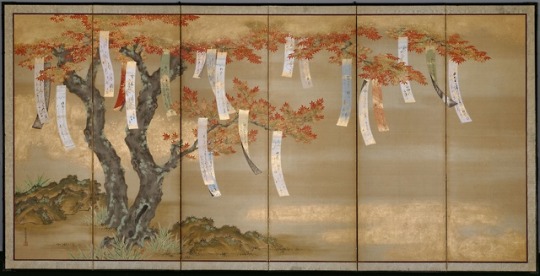
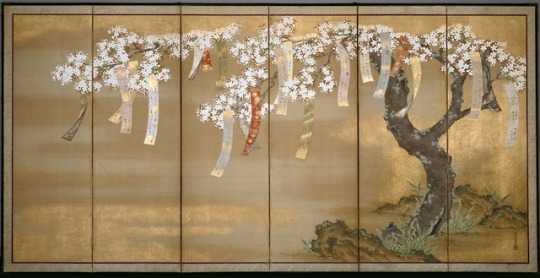
‘Autumn Maples and Flowering Cherry with Poem Slips’ (circa 1675) by Tosa Mitsuoki (Japanese, 1617-1691).
Pair of six-panel screens. Ink, colours, gold leaf, and gold powder on silk.
Images and text information courtesy Art Institute Chicago.
101 notes
·
View notes
Photo

PIRATE'S CHEST~
A heavily painted iron strong box, probably 17th century, probably German, the exterior decorated with painted florals, birds and the occasional angel in a Spanish style, the flat recessed hinged lid carrying a large and elaborate internal lock mechanism working independent bolts and covered by a plate engraved with sprays and mermaid[?] figures, operated with a key through a central keyhole at the top, a dummy keyhole on the front panel, twist drop handles on either end, the interior painted orange and with a smaller locking compartment along one side.
Iron strong boxes of this style are typically of the style used to transport valuables during the 17th and 18th centuries and much more ably designed for the purpose than the wooden chests of lore. Newspaper articles with the present lot record its 1957 purchase by the library for the Driscoll Collection, from Robert Nesmith, author of "Dig for Pirate Treasure." Nesmith had earlier obtained the trunk from the descendants of Rhode Island's Captain Thomas Tew. The Tew family settled in Newport in 1640 and Thomas Tew's grandfather Richard Tew was named in the charter granted in 1663. Prominent family behind him, it did not take the young Tew long after his arrival in Bermuda in 1691 to secure a privateering commission from the governor there. He obtained a crew and sloop, but quickly tired of his official assignment to attack the French in Gambia and instead easily enlisted his crew in more profitable pursuits. (Defoe/Johnson's History of the Pirates relates his crews' reaction to his offer of turning pirate as "A gold chain or a wooden leg-- we'll stand by you.") His first target was a heavily-laden Arab vessel in the Strait of Babelmanded, which yielded each man a share of over 3000 pounds sterling. Tew's adventures continued, with his joining the democratic pirate settlement on Madagascar, "Libertatia", under the "Piracy without Tears" banner of the French Captain, Misson. While in the pirate enclave, a dispute between the French and English pirate crews led to a duel between their commanders, Tew and Misson. A defrocked priest turned pirate settled the dispute amicably and Tew eventually became an admiral in their fleet. Upon his return to New York, Tew was able to pay back his Bermuda investors handsomely, at 14 times their initial investment, and later obtained similar privateering commissions from Rhode Island (though it cost him £500). The captain became quite a celebrity in New York and it was said that the rumours of his preparing for another voyage had sons, rich and poor alike, running away to sneak on board his ship. Tew's success in raiding Eastern shipping was such that for a time Arabian Gold was common in New York. In contrast to popular ideas on the cruelty of pirates, Tew was by most accounts quite humane in his treatment of prisoners and more than one instance has been recounted of ships giving in without a fight when they learned their assailant's identity. In 1696 Captain William Kidd received a king's commission to capture pirates with Thomas Tew being mentioned by name in the document. Kidd quickly turned pirate himself. Thomas Tew was able to escape Execution Dock, he was mortally wounded attacking a ship of the Great Mogul and died a fitting pirate's death. The present lot is featured in the Time/Life publication The Pirates
Price realised USD 63,450, Christie’s.
#tew#pirate#antique#the pirates#piracy#New York City#privateer#captain kidd#william kidd#thomas tew#Bermuda
83 notes
·
View notes
Photo

Tosa Mitsuoki (1617 - 1691) - Autumn Maples with Poem Slips c.1675. Six panel screen. Ink, colour, gold leaf and gold powder on silk.
Click to enlarge.
24 notes
·
View notes
Photo

Interior of the Oude Kerk, Delft by Emanuel de Witte Dutch, c. 1617–1691/2 Oil on panel Holland, c. 1680
Emanuel de Witte, who was a Dutch painter in the Baroque era, was most known for his architectural interiors and church interiors.
Interior of the Oude Kerk, Delft is one of his most famous works. It is an interior of the 17th-century Oude Kerk, or Old Church in Delft, Holland.
The painting is noteworthy for its accurate depiction of the architectural details of the church and its use of light, which was typical of the Dutch manner of painting.
At the time of de Witte’s painting, Holland was going through a period of great social, political and economic change, as the Dutch Republic was defining itself as an independent and powerful country.
The painting of "Interior of the Oude Kerk, Delft" showcases Emanuel de Witte's technical understanding of light and shadow, and his talent for conveying a sense of depth and perspective in his works. The painting is composed with a variety of warm yellows, oranges and browns, lending a lively and energetic atmosphere to the scene. The painting is a faithful depiction of the 17th-century church in Delft, and clearly conveys the feel of the era and the vibrant city of Delft at the height of its power.
Always at your service, AI Art Detective
This blog took 424 OpenAI tokens. This image and it's meta-data are courtesy of The Art Institute of Chicago's public API, which you can visit here.
0 notes
Photo

Theodoras Metochites
With the exception of the nave and dome, therefore, the present church is entirely due to this latter, who spent his last days within its precincts, where he was buried in 1332. The chapel on the right is connected with the inner and outer narthex by a passage. The chapel is adorned with frescoes of angels and saints. The mosaics, already alluded to as illustrative of the life of Christ, are in the nartheces. Those over the main entrance represent Theodoras Metochites presenting the model of the church to Christ seated on a throne. The letters IC, XP, stand for Jesus Christ and the inscription is Xcbpa TCOV ZCOVTCOV (‘ land of the living ). The mosaics on the right and left of the door represent St. Peter and St. Paul. In the body of the church is a mosaic of the Virgin Mary in a garden, with the same inscription, Xcopa TCOV ZCOVTCOV (‘ land of the living ’); and on the south panel another representing Christ holding a gospel with the text, ‘ Come unto Me, all ye that labour and are heavy laden, and I will give you rest.’
Church of the Pantocrator (Almighty), now Zeireck Jamesl; admission 5 piastres;
situated on the heights in the vicinity of the inner bridge, was built in 1120 by John Comnenus and his wife the Empress Irene, both of whom, as well as many other Byzantine emperors, lie buried in the adjoining monastery. This church formerly contained several relics, the most notable being a porphyry slab on which it is supposed Christ was laid out after being taken down from the cross, and an eikon or painting of the Virgin, by St. Luke, brought from Palestine. Only the southern of the three buildings comprising the former church is used as a mosque. The large verde antico sarcophagus to be seen in the vicinity is supposed to have contained the remains of the Empress Irene.
Church of St. John the Baptist and Monastery of Studius, now Mir Akhor Jamesl. Admission not fixed; 5 piastres for two or three persons, and 10 piastres for a party, will be liberal enough guided tours istanbul.
It stands near the Yed! Kuleh (Seven Towers) Railway Station. It was built by Studius, a Roman patrician, who came to Constantinople with Constantine the Great. The monastery attached to the church was occupied by the monks called Acoemetoi (‘ The Wakeful ’), whose days and nights were spent in continual vigils for celebration of divine service. The Akhor, or Master of the Horse to Sultan
Bayazid, converted the church into a mosque, and named it after the office he held.
MOSQUES AND MAUSOLEUMS ERECTED BY THE TURKS
Suleimanieh, or the Mosque of Suleiman ., ‘the Magnificent.’ Admission 5 piastres per head.
This place of worship, built (1550-56) by the famous Turkish architect Sinan, of materials taken from the ancient church of St. Euphemia at Chal- cedon, is one of the finest specimens of Turkish architecture extant. It is 225 feet by 205 feet in area, and its dome is 156 feet high and 86 feet in diameter. The beautiful stained glass in two of the windows near the pulpit was part of the spoil taken during the wars with the Persians; that in the other windows is a clever ancient imitation of the former by Sharhos Ibrahim, a celebrated glass – stainer. The outer court of the mosque is a rectangular arcade with a basin in the centre, and, with its four minarets, is most picturesque.
In a burial-ground adjoining the mosque are the Turbeh, or Mausoleum, of Suleiman the Great, and that of his wife, the famous Roxalana. The tombs of Suleiman the Great, Suleiman II. (died 1691), and the latter’s brother Ahmed II. (died 1695), are of uniform size and shape. Each bears an enormous turban and is surrounded by a wooden railing inlaid with mother-of-pearl. The walls are faced with beautiful tiles of the best period. The building contains also a curious wooden model of the Kaaba at Mecca, and several ancient transcriptions of the Koran. Admission 5 piastres each, a reduction being made for parties of five or more.
0 notes
Photo

Theodoras Metochites
With the exception of the nave and dome, therefore, the present church is entirely due to this latter, who spent his last days within its precincts, where he was buried in 1332. The chapel on the right is connected with the inner and outer narthex by a passage. The chapel is adorned with frescoes of angels and saints. The mosaics, already alluded to as illustrative of the life of Christ, are in the nartheces. Those over the main entrance represent Theodoras Metochites presenting the model of the church to Christ seated on a throne. The letters IC, XP, stand for Jesus Christ and the inscription is Xcbpa TCOV ZCOVTCOV (‘ land of the living ). The mosaics on the right and left of the door represent St. Peter and St. Paul. In the body of the church is a mosaic of the Virgin Mary in a garden, with the same inscription, Xcopa TCOV ZCOVTCOV (‘ land of the living ’); and on the south panel another representing Christ holding a gospel with the text, ‘ Come unto Me, all ye that labour and are heavy laden, and I will give you rest.’
Church of the Pantocrator (Almighty), now Zeireck Jamesl; admission 5 piastres;
situated on the heights in the vicinity of the inner bridge, was built in 1120 by John Comnenus and his wife the Empress Irene, both of whom, as well as many other Byzantine emperors, lie buried in the adjoining monastery. This church formerly contained several relics, the most notable being a porphyry slab on which it is supposed Christ was laid out after being taken down from the cross, and an eikon or painting of the Virgin, by St. Luke, brought from Palestine. Only the southern of the three buildings comprising the former church is used as a mosque. The large verde antico sarcophagus to be seen in the vicinity is supposed to have contained the remains of the Empress Irene.
Church of St. John the Baptist and Monastery of Studius, now Mir Akhor Jamesl. Admission not fixed; 5 piastres for two or three persons, and 10 piastres for a party, will be liberal enough guided tours istanbul.
It stands near the Yed! Kuleh (Seven Towers) Railway Station. It was built by Studius, a Roman patrician, who came to Constantinople with Constantine the Great. The monastery attached to the church was occupied by the monks called Acoemetoi (‘ The Wakeful ’), whose days and nights were spent in continual vigils for celebration of divine service. The Akhor, or Master of the Horse to Sultan
Bayazid, converted the church into a mosque, and named it after the office he held.
MOSQUES AND MAUSOLEUMS ERECTED BY THE TURKS
Suleimanieh, or the Mosque of Suleiman ., ‘the Magnificent.’ Admission 5 piastres per head.
This place of worship, built (1550-56) by the famous Turkish architect Sinan, of materials taken from the ancient church of St. Euphemia at Chal- cedon, is one of the finest specimens of Turkish architecture extant. It is 225 feet by 205 feet in area, and its dome is 156 feet high and 86 feet in diameter. The beautiful stained glass in two of the windows near the pulpit was part of the spoil taken during the wars with the Persians; that in the other windows is a clever ancient imitation of the former by Sharhos Ibrahim, a celebrated glass – stainer. The outer court of the mosque is a rectangular arcade with a basin in the centre, and, with its four minarets, is most picturesque.
In a burial-ground adjoining the mosque are the Turbeh, or Mausoleum, of Suleiman the Great, and that of his wife, the famous Roxalana. The tombs of Suleiman the Great, Suleiman II. (died 1691), and the latter’s brother Ahmed II. (died 1695), are of uniform size and shape. Each bears an enormous turban and is surrounded by a wooden railing inlaid with mother-of-pearl. The walls are faced with beautiful tiles of the best period. The building contains also a curious wooden model of the Kaaba at Mecca, and several ancient transcriptions of the Koran. Admission 5 piastres each, a reduction being made for parties of five or more.
0 notes